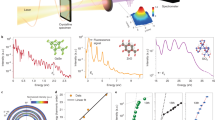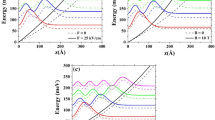Abstract
Second-harmonic generation (SHG), linear electro-optic effect (LEO) and electric-field induced second-harmonic generation (EFISH) are nonlinear optical processes with important applications in optoelectronics and photovoltaics. SHG and LEO are second-order nonlinear optical processes described by second-order susceptibility. Instead, EFISH is a third-order nonlinear optical process described by third-order susceptibility. LEO and EFISH are only observed in the presence of a static electric field. These nonlinear processes are very sensitive to the symmetry of the systems. In particular, LEO is usually observed through a change in the dielectric properties of the material while EFISH can be used to generate a “second harmonic” response in centrosymmetric material. In this work, we present a first-principle formalism to calculate second- and third-order susceptibility for LEO and EFISH. LEO is studied for GaAs semiconductor and compared with the dielectric properties of this material. We also present how it is possible for LEO to include the ionic contribution to the second-order macroscopic susceptibility. Concerning EFISH we present for the first time the theory we developed in the framework of TDDFT to calculate this nonlinear optical process. Our approach permits to obtain an expression for EFISH which does not contain the mathematical divergences in the frequency-dependent second-order susceptibility that caused until now many difficulties for numerical calculations.






Similar content being viewed by others
Data availibility statement
The datasets generated during and/or analysed during the current study are available from the corresponding author on reasonable request.
References
Y.R. Shen, The principles of nonlinear optics (Wiley-Interscience, New York, 1984)
N. Bloembergen, Nonlinear optics (Benjamin Press, New York, 1965)
L.G. Kaake, A. Jailaubekov, K.J. Williams, X.Y. Zhu, Probing ultrafast charge separation at organic donor/acceptor interfaces by a femtosecond electric field meter. Appl. Phys. Lett. 99(8), 083307 (2011)
I.H. Choi, M.S. Kim, C. Kang, J.S. Lee, Ultrafast real-time tracing of surface electric field generated via hot electron transport in polar semiconductors. Appl. Surf. Sci. 571, 151279 (2022)
M. Cazzanelli, F. Bianco, E. Borga, G. Pucker, M. Ghulinyan, E. Degoli, E. Luppi, V. Véniard, S. Ossicini, D. Modotto, R.P.S. Wabnitz, L. Pavesi, Second-harmonic generation in silicon waveguides strained by silicon nitride. Nat. Mater. 11, 148–154 (2012)
M. Bertocchi, E. Luppi, E. Degoli, V. Véniard, S. Ossicini, Defects and strain enhancements of second-harmonic generation in Si/Ge superlattices. J. Chem. Phys. 140(5), 21405 (2014)
M. Bertocchi, E. Luppi, E. Degoli, V. Véniard, S. Ossicini, Large crystal local-field effects in second-harmonic generation of a Si/CaF\({}_{2}\) interface: an ab initio study. Phys. Rev. B 86, 035309 (2012)
E. Luppi, E. Degoli, M. Bertocchi, S. Ossicini, V. Véniard, Strain-designed strategy to induce and enhance second-harmonic generation in centrosymmetric and noncentrosymmetric materials. Phys. Rev. B 92, 075204 (2015)
G.T. Reed, G. Mashanovich, F.Y. Gardes, D.J. Thomson, Silicon optical modulators. Nat. Photon. 4, 518 (2010)
J. Frigerio, V. Vakarin, P. Chaisakul, M. Ferretto, D. Chrastina, X. Le Roux, L. Vivien, G. Isella, D. Marris-Morini, Giant electro-optic effect in Ge/SiGe coupled quantum wells. Sci. Rep. 5, 15398 (2015)
M. Berciano, G. Marcaud, P. Damas, X.L. Roux, P. Crozat, C.A. Ramos, D.P. Galacho, D. Benedikovic, D. Marris-Morini, E. Cassan, L. Vivien, Fast linear electro-optic effect in a centrosymmetric semiconductor. Commun. Phys. 1(1), 64 (2018)
K. Liu, C.R. Ye, S. Khan, V.J. Sorger, Review and perspective on ultrafast wavelength-size electro-optic modulators. Laser Photon. Rev. 9(2), 172–194 (2015)
R.S. Jacobsen, K.N. Andersen, P.I. Borel, J. Fage-Pedersen, L.H. Frandsen, O. Hansen, M. Kristensen, A.V. Lavrinenko, G. Moulin, H. Ou, C. Peucheret, B. Zsigri, A. Bjarklev, Nature 441, 199202 (2006)
C. Castellan, A. Trenti, C. Vecchi, A. Marchesini, M. Mancinelli, M. Ghulinyan, G. Pucker, L. Pavesi, On the origin of second harmonic generation in silicon waveguides with silicon nitride cladding. Sci. Rep. 9(1), 1088 (2019)
L.F. Lastras-Martinez, M. Chavira-Rodriguez, A. Lastras-Martinez, R.E. Balderas-Navarro, Phys. Rev. B 66, 075315 (2002)
L.F. Lastras-Martinez, J.M. Flores-Camacho, A. Lastras-Martinez, R.E. Balderas-Navarro, M. Cardona, Phys. Rev. Lett. 96, 047402 (2006)
W. Ndebeka, P. Neethling, E. Rohwer, C. Steenkamp, J. Bergmann, H. Stafast, Interband and free charge carrier absorption in silicon at 800 nm: experiments and model calculations. Appl. Phys. B 123 (2017)
W.I. Ndebeka, P.H. Neethling, E.G. Rohwer, C.M. Steenkamp, H. Stafast, Counter-intuitive strength of electric field induced second harmonic (EFISH) signals at the rear side of thin silicon membranes. J. Opt. Soc. Am. B 37(11), A228–A236 (2020)
C. Attaccalite, M. Grüning, Nonlinear optics from an ab initio approach by means of the dynamical Berry phase: Application to second- and third-harmonic generation in semiconductors. Phys. Rev. B 88(23), 235113 (2013)
M. Grüning, D. Sangalli, C. Attaccalite, Dielectrics in a time-dependent electric field: a real-time approach based on density-polarization functional theory. Phys. Rev. B 94(3), 035149 (2016)
E. Luppi, H. Hübener, V. Véniard, Ab initio second order optics in solids. Phys. Rev. B 82(23), 235201 (2010)
N. Gauriot, V. Véniard, E. Luppi, Long-range corrected exchange-correlation kernels to describe excitons in second-harmonic generation. J. Chem. Phys. 151(23), 234111 (2019)
L. Prussel, V. Véniard, Linear electro-optic effect in semiconductors: ab initio description of the electronic contribution. Phys. Rev. B 97, 205201 (2018)
R. Bavli, Y.B. Band, Relationship between second-harmonic generation and electric-field-induced second-harmonic generation. Phys. Rev. A 43, 507–514 (1991)
S. Ramasesha, I.D.L. Albert, Model exact study of dc-electric-field-induced second-harmonic-generation coefficients in polyene systems. Phys. Rev. B 42, 8587–8594 (1990)
A. Alejo-Molina, K. Hingerl, H. Hardhienata, Model of third harmonic generation and electric field induced optical second harmonic using simplified bond-hyperpolarizability model. J. Opt. Soc. Am. B 32(4), 562–570 (2015)
C. Aversa, J.E. Sipe, Nonlinear optical susceptibilities of semiconductors: results with a length-gauge analysis. Phys. Rev. B 52(20), 14636–14645 (1995)
K. Kikuchi, K. Tada, Theory of electric field-induced optical second harmonic generation in semiconductors. Opt. Quant. Electron. 12(3), 199–205 (1980)
N. Suzuki, K. Tada, Elastooptic and electrooptic properties of GaAs. Jpn. J. Appl. Phys. 23(8R), 1011 (1984)
G. Irmer, C. Roder, C. Himcinschi, J. Kortus, Raman tensor elements and faust-henry coefficients of wurtzite-type \(\alpha\)-GaN: How to overcome the dilemma of the sign of faust-henry coefficients in \(\alpha\)-GaN? J. Appl. Phys. 116(24), 245702 (2014)
G. Irmer, C. Roder, C. Himcinschi, J. Kortus, Nonlinear optical coefficients of wurtzite-type \(\alpha\)-GaN determined by Raman spectroscopy. Phys. Rev. B 94(19), 195201 (2016)
M. Veithen, X. Gonze, P. Ghosez, Nonlinear optical susceptibilities, raman efficiencies, and electro-optical tensors from first-principles density functional perturbation theory. Phys. Rev. B 71(12), 125107 (2005)
L. Prussel, Ab-initio description of optical nonlinear properties of semiconductors in the presence of an electrostatic field. Ph.D. thesis, Ecole Polytechnique, Université Paris-Saclay (2017). https://pastel.archives-ouvertes.fr/tel-01661472
X. Gonze, B. Amadon, P.-M. Anglade, J.-M. Beuken, F. Bottin, P. Boulanger, F. Bruneval, D. Caliste, R. Caracas, M. Cote, T. Deutsch, L. Genovese, Ph Ghosez, M. Giantomassi, S. Goedecker, D.R. Hamann, P. Hermet, F. Jollet, G. Jomard, S. Leroux, M. Mancini, S. Mazevet, M.J.T. Oliveira, G. Onida, Y. Pouillon, T. Rangel, G.-M. Rignanese, D. Sangalli, R. Shaltaf, M. Torrent, M.J. Verstraete, G. Zerah, J.W. Zwanziger, ABINIT: First-principles approach to material and nanosystem properties. Comput. Phys. Commun. 180, 2582–2615 (2009)
X. Gonze, G.-M. Rignanese, M. Verstraete, J.-M. Beuken, Y. Pouillon, R. Caracas, F. Jollet, M. Torrent, G. Zerah, M. Mikami, Ph Ghosez, M. Veithen, J.-Y. Raty, V. Olevano, F. Bruneval, L. Reining, R. Godby, G. Onida, D.R. Hamann, D.C. Allan, A brief introduction to the ABINIT software package. Zeit. Kristallogr. 220, 558–562 (2005)
The ABINIT code is a common project of the Université Catholique de Louvain, Corning Incorporated, and other contributors (http://www.abinit.org)
F. Sottile, L. Reining, V. Olevano, The DP code, https://etsf.polytechnique.fr/software/AbInitio/
S. Adachi, GaAs and related materials: bulk Semiconducting and Superlattice properties (World Scientific, Teaneck, 1994)
Acknowledgements
This work was performed using HPC resources from GENCI-IDRIS Grant 090544.
Author information
Authors and Affiliations
Corresponding authors
Additional information
Ultrafast Phenomena from attosecond to picosecond timescales: theory and experiments. Guest editors: Franck Lépine, Lionel Poisson.
Appendices
Appendix 1
Writing a time-dependent electric field as
the time-dependent second-order polarization induced by \({\mathbf {E}}(t)\) is
where the second-order susceptibility \(\chi ^{(2)}\) relates the polarization to the electric field. The first term corresponds to the second harmonic generation (SHG) and the second term to the optical rectification (OR).One can define a frequency-dependent SHG an OR polarization as \({\mathbf {P}}^{(2)}_{\mathrm{SHG}}(2\omega )=\chi ^{(2)}_{\mathrm{SHG}} E_0^2\) and \({\mathbf {P}}^{(2)}_{\mathrm{OR}}=2\chi ^{(2)}_{OR} E_0^2\).
In the general case, where the electric field contains two different frequencies,
the time-dependent second-order polarization becomes
where the last two terms correspond respectively to the sum frequency generation (SFG) and the difference frequency generation (DFG).
For the linear electro-optic effect (LEO), the total field is
where \(E_{\mathrm{dc}}=\lim \limits _{\omega \rightarrow 0}E_2(t)=2E_{0,2}\). The polarization corresponding to the linear electro-optic effect is then
One can generalize these conventions to the third order case and we get for the EFISH process
Appendix 2
In this Appendix, we present the detailed derivation of the ionic contribution to the LEO susceptibility. The frequency-dependent dielectric tensor depends on the frequency \(\omega\), on the amplitude of the static electric field \({\mathcal {E}}\) and on the ionic displacement induced by the static field \({\mathbf {R}}(\pmb{\mathcal{E}})\). The ionic contribution is given by
The evaluation of \(\frac{\partial \tau _{n \alpha } }{\partial {\mathcal {E}}_{k}}\vert _{{\mathcal {E}}_{k}=0}\) has been proposed in [32]; it is based on the fact that the electric enthalpy \(F(\pmb{\mathcal{E}})\) of a solid in an electric field is obtained by the minimization
Expanding the electric enthalpy in terms of the static field, we get
and, to first order in terms of \(\pmb{\mathcal{E}}\), the minimization leads to
By decomposing \(\tau _{n'\alpha '}\) in the basis of the zone-center phonon-mode eigendisplacements(\({\mathbf {q}}=0\)):
we get
Multiplying by \(U_p(n\alpha )\) and summing over \(n\alpha\)
we finally obtain
where we have used the fact that the second derivative of the enthalpy in Eq. (36) corresponds to the inter-atomic forces \(M_n\) and the normalisation relation for the phonon modes \(\sum _{n\alpha } M_{n} U_{m}(n \alpha )U_p(n\alpha )=\delta _{mp}\).
From Eqs. (30) and (37) and with the definition of the mode polarity, \(p_{mk}=\Omega _0 \sum _{n\alpha }\frac{\partial {\mathcal {P}}_k({\mathbf {R}})}{\partial \tau _{n\alpha }}U_m(n\alpha )\), the ionic contribution becomes
Rights and permissions
Springer Nature or its licensor (e.g. a society or other partner) holds exclusive rights to this article under a publishing agreement with the author(s) or other rightsholder(s); author self-archiving of the accepted manuscript version of this article is solely governed by the terms of such publishing agreement and applicable law.
About this article
Cite this article
Prussel, L., Maji, R., Degoli, E. et al. Ab initio nonlinear optics in solids: linear electro-optic effect and electric-field induced second-harmonic generation. Eur. Phys. J. Spec. Top. 232, 2231–2240 (2023). https://doi.org/10.1140/epjs/s11734-022-00677-5
Received:
Accepted:
Published:
Issue Date:
DOI: https://doi.org/10.1140/epjs/s11734-022-00677-5




